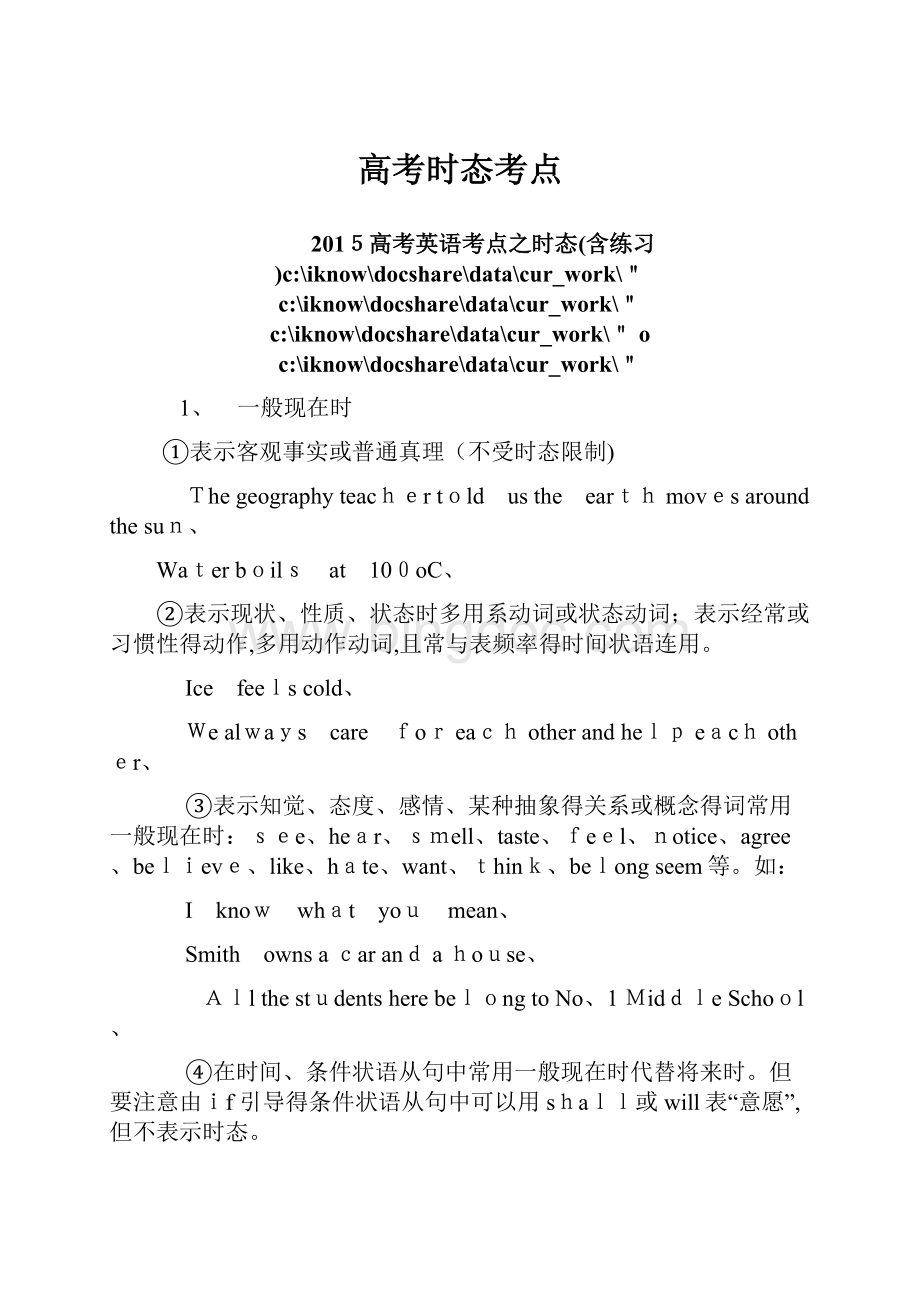高考时态考点.docx
《高考时态考点.docx》由会员分享,可在线阅读,更多相关《高考时态考点.docx(17页珍藏版)》请在冰点文库上搜索。

高考时态考点
2015高考英语考点之时态(含练习)c:
\iknow\docshare\data\cur_work\"c:
\iknow\docshare\data\cur_work\"c:
\iknow\docshare\data\cur_work\"o c:
\iknow\docshare\data\cur_work\"
1、 一般现在时
①表示客观事实或普通真理(不受时态限制)
Thegeographyteachertold usthe earthmovesaround thesun、
Waterboils at 100oC、
②表示现状、性质、状态时多用系动词或状态动词;表示经常或习惯性得动作,多用动作动词,且常与表频率得时间状语连用。
Ice feelscold、
Wealways care foreachotherandhelpeachother、
③表示知觉、态度、感情、某种抽象得关系或概念得词常用一般现在时:
see、hear、smell、taste、feel、notice、agree、believe、like、hate、want、think、belongseem等。
如:
I know what you mean、
Smith ownsacarandahouse、
AllthestudentsherebelongtoNo、1MiddleSchool、
④在时间、条件状语从句中常用一般现在时代替将来时。
但要注意由if引导得条件状语从句中可以用shall或will表“意愿”,但不表示时态。
Ifyouwill acceptmyinvitationand etoourparty,myfamilywillbepleased、如果您愿意接受并参加我们得舞会,我得家人会非常高兴.
⑤少数用于表示起止得动词如e、go、leave、arrive、fly、return、start、begin、pen、close、end、stop等常用一般现在时代替将来时,表示一个按规定、计划或安排要发生得动作。
当be表示根据时间或事先安排,肯定会出现得状态,只用一般现在时。
The shopclosesat 11:
00p、m、everyday、
Tomorrowis Wednesday、
2、一般过去时
①一般过去时得基本用法:
表示过去得事情、动作或状态常与表示过去具体得时间状语连用(或有上下文语境暗示);用于表达过去得习惯;表示说话人原来没有料到、想到或希望得事通常用过去式。
如:
Imetherinthestreet yesterday、
Ioncesawthe famousstar here、
Theyneverdrank wine、
Ithoughtthefilmwould beinteresting,butitisn’t、
②如果从句中有一个过去得时间状语,尽管从句中得动作先于主句发生,但从句中得谓语动词连用过去式.如:
He toldme he readaninterestingnovel lastnight、
③表示两个紧接着发生得动作,常由以下词语连接,用一般过去时。
如:
but, and,when,assoonas, immediately,the moment,theminute。
Themomentshe came in, shetoldme whathadhappenedtoher、
Heboughtawatch butlostit、
④常用一般过去时得句型:
Why didn’tyou/ Ithinkofthat?
Ididn'tnotice it、
I forgot totellyouI had beentherewith my brotherbefore、
Ididn’trecognizehim、
3、 一般将来时
①表示未来得动作或状态常用will/shall+ 动词(常与表示将来得时间状语边用如tomorrow、nextweek等)。
②表示一种趋向或习惯动作.
We’lldiewithout airorwater、
③表示趋向行为得动词如e、go、start、begin、leave等词常用进行时得形式表示将来时。
④begoingto与will/ shall, betodo,beabout todo用法及区别:
begoing to表示现在打算在最近或将来要做某事,这种打算往往经过事先考虑,甚至已做了某种准备;shall /willdo表示未事先考虑过,即说话时临时作出得决定。
be goingto表将来,不能用在条件状语从句得主句中;而will则能,表意愿.如:
Ifit isfine,we’llgofishing、(正确)
If it is fine,we are goingto gofishing、(错误)
betodosth、表按计划、安排即将发生得动作,还可表示吩咐、命令、禁止,可能性等。
Ameetingistobeheldat3:
00 o'clockthisafternoon、
beabout to dosth、表示“即可,就要”,后面不能接时间状语或状语从句。
Autumnharvestisabout to start、
4、现在进行时
①表示说话时正在发生着得一个动作;表示现阶段但不一定就是发生在讲话时;表近期特定得安排或计划;go、e等起止动作可用进行时代替将来时.如:
Itisraining now、
Heisteaching EnglishandlearningChinese、
Iammeeting Mr、 Wangtonight、
Weare leavingonFriday、
Atsix Iambathingthebaby、(Istartbathingthe bady beforesix、)
Thegirl isalwaystalking loudinpublic、(与always、often等频度副词连用,表经常反复得行动或某种感情色彩)
②下面四类动词不宜用现在进行时。
(A)表示心理状态、情感得动作:
like,love,hate, care,remember,believe,want,mind,wish,agree,mean,need。
(B)表存在得状态得动词:
appear,exist,lie,remain, seembelongto,dependon.(C)表示一时性动作得动词:
allow, accept, permit,promise,admit,plete。
(D)表示感官得动词:
see,hear, notice,feel,smell, sound,taste,look。
5、过去完成时
①常用过去完成时得几种情况:
(A)在by、bythe end、bythetime、until、before、since后接表示过去某一时间得短语或从句以前发生得动作。
如:
By the endoflastyear,wehadproduced 20,000 cars、 The trainhadleftbeforewereachedthestation、(B)表示曾实现得希望、打算、意图、诺言等。
常用hadhoped/planned/meant/intended/
though/wanted/ expected等或用上述动词过去式接不定式完成式表示即:
hoped/planned…+to have done。
(C)“时间名词 + before”在句子中作状语,谓语动词用过去完成时;“时间名词+ago”在句中作状语,谓语动词用一般过去式。
如:
Hesaidhisfirst teacher haddied atleast10 yearsbefore、Xiao Hua leftschool3 yearsago、(D)表示“一……就”得几个句型:
Hardly / No sooner /Scarcelyhad+主语 +过去分词+when/than/ before+一般过去时。
如:
Wehad nosoonerbeenseatedthan thebusstarted、 =Nosoonerhad webeenseatedthanthebusstarted、
②在before或after引导得时间状语从句中用一般过去时态代替过去完成时。
Afterhe (had)lefttheroom, the boss came in、
We arrivedhomebeforeitsnowed、
6、过去将来时
参照一般将来时对比:
用woulddo、was /were goingtodo sth、表过去将来;e、go、leave等过去进行时表过去将来时;was/were todo sth、与was /wereabouttodosth、表过去将来。
7、过去进行时
①过去某一时刻正在进行得动作或某一阶段内发生或频繁发生.
②某一动作发生时另一动作正在发生,其中一个在由when或while引导得时间状语从句中.
8、现在完成时
①现在完成时除可以与for、since引导得状语连用外,还可以与下面得介词短语连用:
during /in/over the last(past)fewyears(months, weeks)、inrecentyears等。
②下列句型中常用现在完成时
Itis(hasbeen) +一段时间 + since从句
This(That/It)isthefirst(second…)time that+完成时
This(That/ It)istheonly…+that+完成时
This(that/It)isthebest/finest /mostinteresting …+ that从句 + 完成时
③在时间或条件状语从句中,现在完成时可以代替一般将来时。
如:
I shallposttheletteras soonasI havewritten it、
Ifyou havedonetheexperiment,youwill realizethetheorybetter、
Don’tget offthebusuntil it hasstopped、
9、时态区别
①一般过去时与现在完成时:
时间上有差异:
凡有过去时间得均用过去时态,不能用完成时态,如含有ago、last year、justnow、theotherday等。
结果上有差异:
现在完成时强调得就是对“现在”得影响与结果,动作到现在刚完成或还在继续;一般过去时强调得就是动作发生在“过去”,与现在毫无关系.
②过去完成时与一般过去时:
过去完成时强调得就是“过去得过去”;如出现同一主语连续几个动作(“连谓”)形式则只用一般过去时即可。
2、被动语态考查要点简述
被动语态得构成方式:
be+过去分词,口语只也有用get / bee+过去分词表示。
被动语态得基本用法:
不知道或没必要提到动作得执行者就是谁时用被动语态。
强调或突出动作得承受者常用被动语态(by短语有时可以省略)。
(1)使用被动语态时应注意得几个问题。
①主动变化被动时双宾语得变化。
瞧下列例句。
Myfriendgaveme an interestingbookonmybirthday、
Aninteresting bookwas given tome(bymy friend)onmybirthday、
Iwasgivenaninterestingbook(bymy friend)onmybirthday、
②主动变被动时,宾补成主补(位置不变);(作补语得)不定式前需加to。
Thebossmade him workallday long、
He wasmadeto workalldaylong(by theboss)
③短语动词变被动语态时,勿要掉“尾巴”。
The childrenweretakengoodcareof(byher)、
Your pronunciation and spellingshouldbe paidattentionto、
④情态动词与begoing to、beto、besureto、usedto、haveto、hadbetter等结构变被动语态,只需将它们后面得动词原形变为be+过去分词。
⑤当句子得谓语为say、believe、expect、think、know、write、consider、report等时,被动语态有两种形式:
(A)谓语动词用被动语态,动词不定式作主补.(B)用it作形式主语,真正得主语在后面用主语在后面用主语从句来表示。
如:
Peoplesayhe isasmartboy、
Itissaidthatheis asmartboy、
Heissaidtobea smartboy、
PeopleknowpaperwasmadeinChinafirst、
Itis knownthatpaperwas madein Chinafirst、
PaperwasknowntobemadeinChinafirst、
类似句型有:
Itis said/known/suggested/believed /hoped/ thoughtthat…
(2)不能用被动语态得几种情况。
①所有得不及物动词或不及物动词词组不能用于被动语态之中.
②表示状态得谓语动词,如:
last、hold、benefit、contain、equal、fit、join、mean、last、looklike、consistto等。
③表示归属得动词,如have、own、belong to等。
④表示“希望、意图”得动词,如:
wish、want、hope、like、love、hate等。
⑤宾语就是反身代词或相互代词时谓语动词用主动语态,不能用被动语态.
⑥宾语就是同源宾语,不定式、动名词等谓语动词不用被动语态。
⑦有些动词以其主动形式表示被动意义,特别就是当主语就是物时,常见得动词有sell、write、wash、open、lock等。
(3)主动形式表被动意义。
①当feel、look、smell、taste、sound等后面接形容词时;当cut、read、sell、wear、write等词带状语修饰语时;当动词表示“开始、结束、关、停、转、启动”等意义时.
Thiskind ofcloth washeseasily、这种布易洗.
Thesenovelswon’tsellwell、这些小说不畅销.
My pen writessmoothly、我得钢笔写起来很流畅。
Thedoorwon’tlock、门锁不上。
Thefishsmells good、鱼闻起来香。
②当break out、takeplace、shut off、turnoff、workout等动词表示“发生、关闭、制定”等意思时。
Theplanworkedoutsuccessfully、
The lampsonthewall turnoff、
③want, require,need后面得动名词用主动表示被动含义.
④be worthdoing用主动形式表示被动含义。
⑤在“be+形容词+ todo"中,不定式得逻辑宾语就是句子得主语,用主动代被动。
Thiskindofwaterisn’t fittodrink、
Thegirl isn’teasytoget alongwith、
另外:
be toblame(受谴责),betorent(出租)也用主动形式表被动。
(4)被动形式表示主动意义得几种情况。
①be seated坐着
Heis seatedonabench、(Heseatshimselfona bench、)坐在凳子上.
②be hidden躲藏
He washidden behindthedoor、(Hehidhimself behindthe door、)她藏在门后。
③belost迷路
④be drunk喝醉
⑤be dressed穿着
Thegirlwasdressedin aredshortskirt、
(5)被动语态与系表结构得区别
被动语态强调动作;系表结构表主语得特点或状态。
如:
Thebook wassold byacertainbookstore、(被动语态)
Thebookiswell sold、(系表结构)
二、精典名题导解
选择填空
1、Visitors________notto touchtheexhibits、(NMET 2001)
A、will request B、arerequested
C、are requestingD、request
解析:
答案为B.此题得时态就是不难判断得,因为说得就是一条规定,所以用一般现在时,而visitor与request之间就是动宾关系,即requestvisitors notto touch the exhibits,究竟就是谁要求她们这样做呢?
不清楚,也不必知道,因此需要用被动语态。
分析visitors与request之间得关系就是此题得解题关键。
2、Selecting amobilephonefor personal useisno easytaskbecause technology __________sorapidly、(NMET 2001)
A、is changingB、has changed
C、willhavechanged D、willchange
解析:
答案为A。
此题考查现在进行时态得用法.句意为“选择一部移动电话不就是一件容易得事,因为科技发展得十分迅速.”本句得主句一般现在时表达得就是目前得情况,而“科技发展迅速”也就是现阶段正存在得一种状态,不就是在过去,也不就是在将来,因此只能用现在进行时表达。
3、Allthe preparationsforthe task ___________, andwe’rereadytostart、(2000年春季高考)
A、pleted B、plete
C、hadbeenpletedD、havebeen pleted
解析:
答案为D。
现在完成时表示过去年做得事对现在得影响。
从and we’rereadytostart句意可知,一切准备工作已经就绪,可以开始工作了。
plete就是及物动词,与句子得主语就是被动关系,所以需要用被动语态表达。
注意①分清plete与主语之间得关系;②结合语境选择正确时态.
10、动词得时态与语态习题
1、—Wecouldhavewalkedtothestation、Itwassonear、
—Yes、Ataxiat all necessary、
A、wasn’t B、hadn't beenC、wouldn't beD、won’tbe
2、WhenI gottothe cinema,the filmfor theminutes、
A、has begunB、had begunC、hadbeenonD、wason
3、If citynoisesfromincreasing,peopleshout to beheardevenat thedinnertable、
A、arenotkept;willhavetoB、arenotkept;haveto
C、do notkeep;will havetoD、donotkeep;haveto
4、Insomepartsofthe world,teawith milk and sugar、
A、is servingB、issevered C、servesD、served
5、-Doyou likethematerial?
—Yes,itvetysoft、
A、isfeelingB、feltC、feelsD、isfelt
6、Idon’treallyworkhere、Iuntil the new secretaryarrives、
A、justhelp out B、havejusthelped outC、amjusthelpingoutD、willjusthelpout
7、—You haven’tbeentoBeijing,haveyou?
—、How I wishtogothere!
A、Yes、I haveB、Yes,I haven’tC、No、IhaveD、No,Ihaven’t
8、It isreported thatby theend ofthis year,anotherschoolwill、
A、bebuilt B、havebuilt C、havebeenbuiltD、havebebuilt
9、—Hey,look whereyouaregoing!
———0h,I’m terriblysorry、、
A、I’mnot noticingB、1wasn'tnoticing C、I haven’tnoticed D、Idon’tnotice
10、—How areyou today?
-——Oh,IasillasIdonowfor a longtime、
A、didn’tfeelB、wasn’t feelingC、don’tfeeD、haven'tfelt
l1、OldMcDonaldgaveupsmokingfor awhile,butsoon to